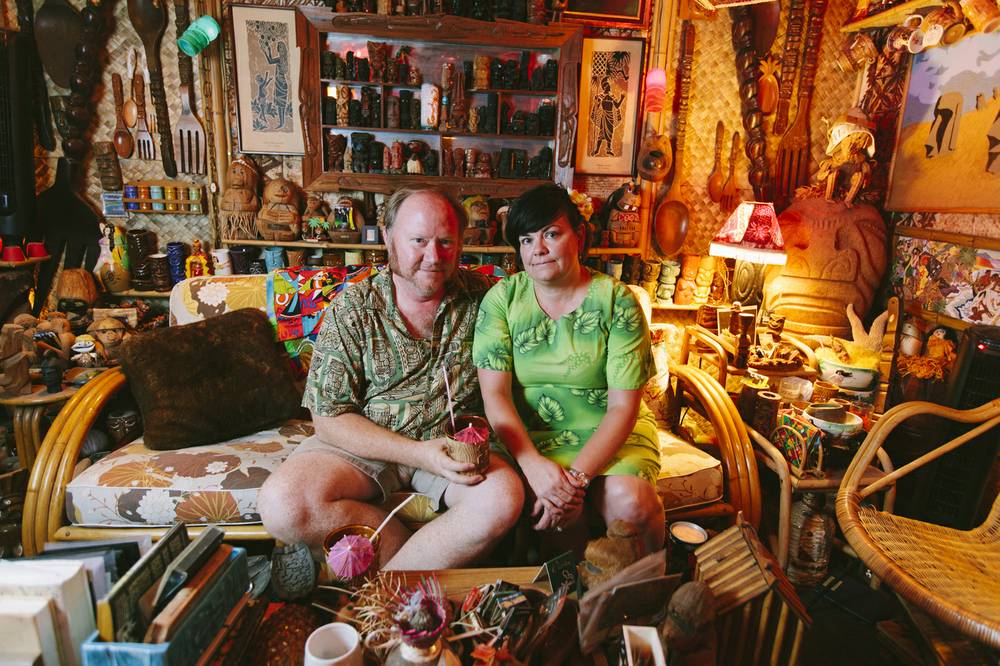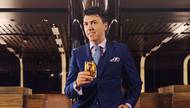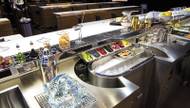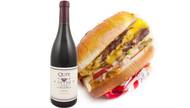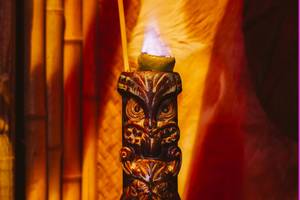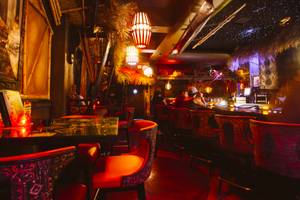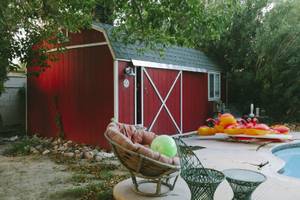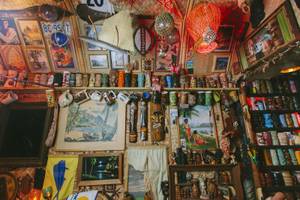Don’t be fooled by the tropical garnish or the swizzle stick—decorative tiki drinks pack a punch.
“People think girly, little umbrella, stuff like that, but there’s often several shots of booze in the typical tiki drink,” says Las Vegas tiki enthusiast Bruce Smiley. “There’s usually more booze than in the Jack and Coke you normally have.”
Tiki culture first emerged in California in 1934. Don the Beachcomber launched in LA and Trader Vic’s in San Francisco, introducing exotic cocktails with heavy pours of rum, which was cheap to come by after Prohibition ended a year earlier. The heady concoctions and intriguing decor were welcome diversions, a chance to whisk away to paradise for an evening.
“In the 1930s, people didn’t have money to go on vacation. It was the Depression,” says Branden Powers, founder of the Golden Tiki bar in Chinatown. “They couldn’t afford to travel, so they would go to these [bars] to escape.”
Bruce Smiley and his wife, Suzanne, built the escape into their home, having sought all things tiki for more than 30 years. They’ve amassed an astonishing 300-plus mugs, as well as carvings, themed art and exotica music, which is richly described by the online Exotica Project: “Set against a tableaux of lush strings, punctuated by bird calls, made to shimmer and dance with Afro-Cuban percussion, vibraphones and mad jungle flutes, it was music manufactured to take the suburban classes to 5 o’clock dreamland.”
The Smileys showcase their treasure trove in a backyard-shed bar they call the 4H Club (for Hubert’s Huli Huli Haus), “the best nonsmoking tiki bar in Las Vegas.” It’s a jaw-dropping space, a tiny, secret oasis full of eBay and thrift finds, souvenirs from island travels and friends’ artwork.
Suzanne’s obsession began with cocktail umbrellas when she was a child, at a tiki-themed Chinese restaurant in New York. Chinese food was often served in tiki venues because, not long ago, it was still exotic to most Americans.
“The whole thing is to have everything correct,” Bruce says of going tiki. “I don’t mean that in a snobbish way. ... What I mean is an immersive environment with the proper music on. … There’s a holistic thing to being in a themed environment.”
So what do you need to have this immersive experience? “Umbrellas,” Suzanne jokes. The Smileys agree on four essentials: environment, music, a decent drink and, if possible, colorful themed threads.
The Booze Issue
- Tiki time: Fruity drinks and flowered shirts are only the beginning
- Las Vegas booze distributors use education as sales tool
- Ellis Island's Village Pub empire hits that friendly neighborhood-bar sweet spot
- Making kombucha with mom: strengthen your scoby, this is gonna get weird
- Aria created its own world-class cognac and you can't afford it
- The Food-Centric Beers of Moody Tongue Brewing have arrived
- Fine booze pairings for the discriminating fast-food fan
- Surrender to the blender!
- The (Motley Brews) boys are back in (Down)town
- PT's has something brewing for 2016
- The search for sours: learn to conquer the newest trend in craft beer
Powers’ collection has a very public outlet in his bar. He got into tiki culture in the early ’90s, during the peak of its resurgence. He has mugs and thousands of records by exotica favorites such as Les Baxter, Arthur Lyman and Martin Denny. And his clientele is bolstered by the fact that tiki picked up momentum again in the early 2000s.
“The tiki resurgence brought about a whole new generation of sculptors and carvers,” Bruce says. Some make commercial mugs, some craft limited batches. At the 4H Club, the Smileys have about 200 “party mugs” or less-precious tiki vessels on hand for any occasion.
“You don’t serve this cocktail in a Solo cup,” Suzanne says, raising her mug.
